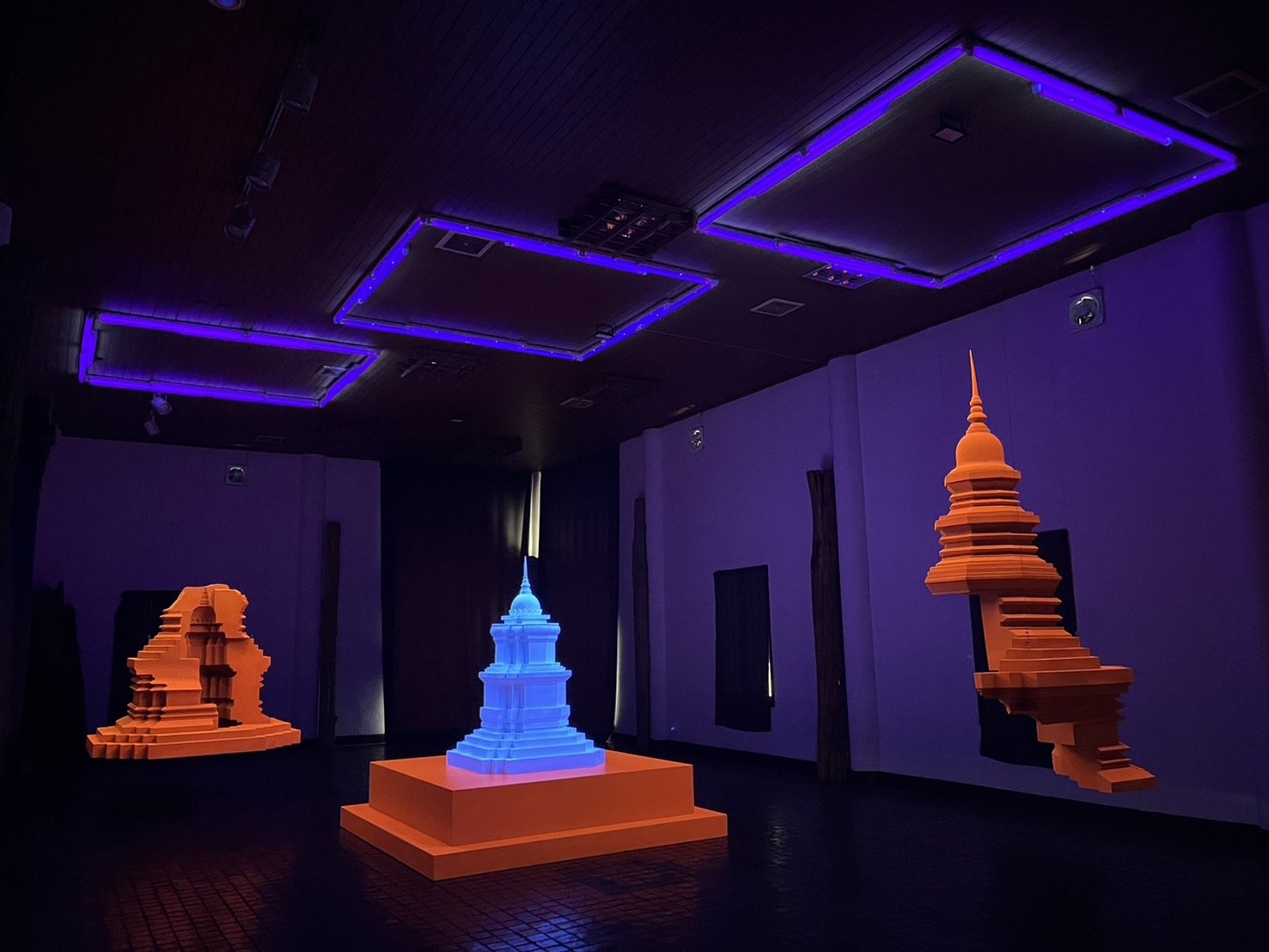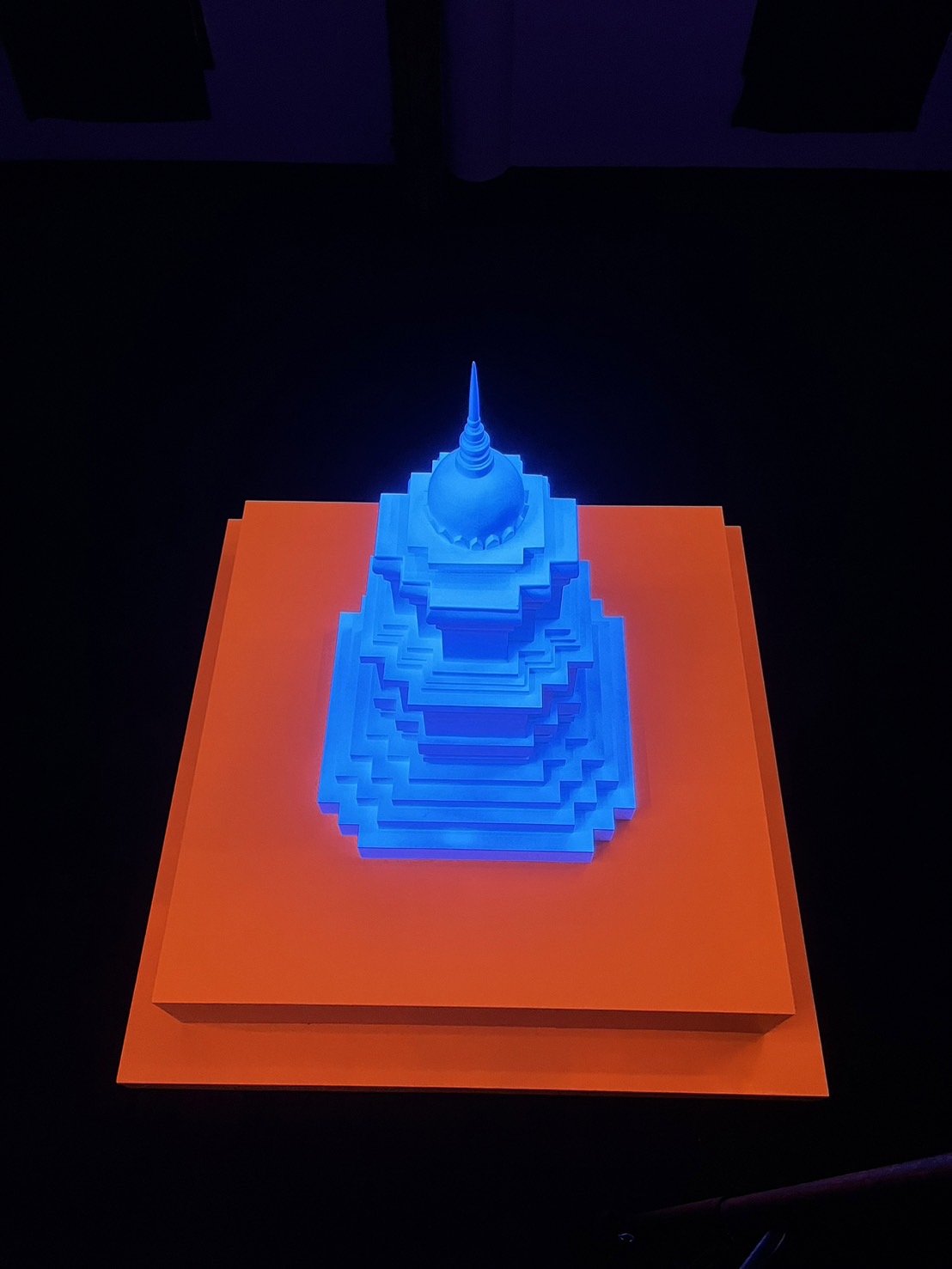
បើកចេតិយ (២០២៣)
ចម្លាក់ ៣ បំណែក ធ្វើពីស្នោ, សន្លឹកឈើ និងថ្នាំលាប fluorescent
២៧៧.៥ x ១២៩.៥ x ៩៨ cm, ២១០ x ២៣៧ x ២៣៧ cm, ១៦៥ x ១៨២ x ១៨២ cm
គំនូសឌីជីថល៖ គង់ ស៊ីដែន
ផលិតកម្ម និងដំឡើង៖ ស្ទូឌីយោ Supernormal
រូបថត៖ ស្ទូឌីយោ Supernormal
ឧបត្ថម្ភដោយ Thailand Biennale Chiang Rai ២០២៣
ខ្ញុំទទួលបានគំនិតសម្រាប់ស្នាដៃនេះពី ចេតិយនៅវត្តអធិទន់កែវ ទីក្រុងឈៀងសែន ខេត្តឈៀងរ៉ៃ ប្រទេសថៃ។ វត្ត និងចេតិយនេះ ត្រូវបានសាងសង់ឡើងក្នុងឆ្នាំ ១៥១៥ ដោយស្តេចព្រះមួងកែវ (ជាវត្តដំបូងដែលទ្រង់បានសាងសង់នៅឈៀងសែន) ដែលជាផ្នែកមួយក្នុងការផ្សះផ្សារទំនាស់រវាងពុទ្ធសាសនានិកាយផ្សេងៗគ្នានៅទីនោះ។ ដោយសារពេលវេលា និងអាកាសធាតុ ចេតិយនេះ (ដែលមានរចនាបថឡានណា) បានប្រេះបែក និងបង្ហាញអោយឃើញនូវចេតិយមួយទៀតនៅខាងក្នុង (ស្រដៀងនឹងរចនាបថសុខោទ័យ) ដែលមើលទៅនៅល្អមិនទាន់ខូចខាត។ អវត្ដមានរបស់ផ្នែកមួយនៃស្រទាប់ខាងក្រៅ បានធ្វើឲ្យចេតិយខាងក្នុងអាចមើលឃើញ។
ការស្រោបចេតិយជាស្រទាប់ គឺជាការអនុវត្តមួយក្នុងន័យអភិរក្ស និងគាំទ្រដល់ព្រះពុទ្ធសាសនា ដែលគេឃើញមានជារឿយៗនៅក្នុងប្រទេសថៃ និងអាស៊ីអាគ្នេយ៍។ តែទោះជាយ៉ាងណាក៏ដោយ វាក៏បង្ហាញពីអំណាច និងឥទ្ធិពលរបស់អ្នកគ្រប់គ្រងឡើងថ្មីផងដែរ។ តើយើងអាចរៀនបានធ្វីពីចេតិយពីរស្រទាប់? ជាកិច្ចខិតខំប្រឹងប្រែងអភិរក្ស ឬការធ្វើឱ្យកាន់តែធំសម្បើម ឬការលាក់កំបាំង? តើអ្វីដែលត្រូវបានគេបង្ហាញឲ្យឃើញ ហើយអ្វីដែលត្រូវបានលាក់មិនឲ្យមើលឃើញ?
ស្នាដៃ «បើកចេតិយ» គឺជាចម្លាក់ ៣ បំណែក ដែលគូស និង «បើក» ចេតិយនៃវត្តអធិទន់កែវ។ ដោយបកស្រទាប់ចេតិយខាងក្រៅចេញទាំងស្រុង ចេតិយខាងក្នុងត្រូវបានផ្តល់នូវសេរីភាព ហើយអាចមើលឃើញយ៉ាងពេញលេញ។ គុណភាពពន្លឺ និងការដំឡើងអណ្តែតក្នុងលំហរបស់ស្នាដៃ បង្កើតបាននូវបទពិសោធន៍មួយហាក់ដូចជានៅពិភពផ្សេង ដែលធ្វើឲ្យយើងចោទសួរអំពីគំហើញ និងការពិត។
Open Chedi (2023)
3-pieces sculpture, polystyrene foam, plywood, fluorescent paint
277.5 x 129.5 x 98 cm, 210 x 237 x 237 cm, 165 x 182 x 182 cm
Installation views at Mae Fah Luang Art and Cultural Park, Chiang Rai
Digital rendering: Kong Siden
Production and installation: Supernormal Studio
Photos: Supernormal Studio, Angkrit Ajchariyasophon
Commissioned by Thailand Biennale Chiang Rai 2023
I was inspired by the Chedi at Wat Athi Ton Kaeo in Chiang Saen, Chiang Rai. The Wat and Chedi were built in 1515 A.D. by King Phra Muang Kaeo (the first Wat he built in Chiang Saen) as part of his effort to reconcile the conflicting different sects of Buddhist monks there. Due to time and weather, the Chedi (in Lan Na style) cracked and exposed an inner one (similar to the Sukhothai style), which appears intact. The absence of a part of the outer layer made the inner structure visible.
Encasing Buddhist Chedi is a common cultural practice of Chedi preservation and support of Buddhism in Thailand and Southeast Asia. However, it also demonstrates the power and authority of successive rulers. How can we learn from a two-layered Chedi? An effort to preserve, make grander, or conceal? What gets seen, and what gets hidden?
Open Chedi is a 3-pieces sculpture that maps and “opens” the Chedi of Wat Athi Ton Kaeo. By completely peeling off the outer structure, the inner Chedi is freed and fully visible. The work's luminescent quality and hovering installation propose an otherworldly experience that challenges our perception of visibility and reality.








